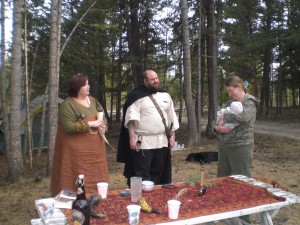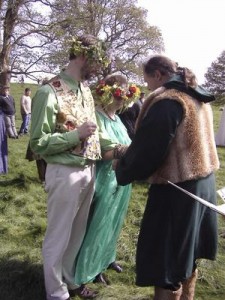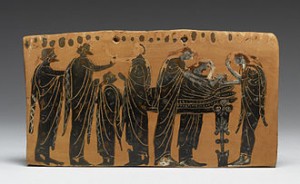A rite of passage is a ritual or ceremony to celebrate and mark the passage from one phase of life to the next. Rites of passage ease us over the threshold into the next phase, and help us to understand and embrace our new status.
Baby Naming
Most cultures have some kind of naming ceremony for babies, and Pagans do too. Pagans generally believe that children should be able to choose whether and which religion to follow when they are old enough, so Pagan naming ceremonies do not include a pledge to bring the child up Pagan – though they may include a desire to instil Pagan values into the child.

Coming of Age
Western culture generally lacks a single unified coming of age ritual. Judaism has one in the form of the Bat Mitzvah and Bar Mitzvah. Many Pagans celebrate the first menstruation of their daughters (as long as the daughters want to celebrate it). Many indigenous cultures have rites of passage into adulthood, in the form of a vision quest in the wilderness.
Coming Out
Coming out as LGBT is definitely a rite of passage, and usually a very liberating and empowering experience as the person who comes out feels more authentic as a result. I have written a Pagan coming-out ritual exploring some of the themes around coming out.
Initiation
Several Pagan and other religious traditions have initiation ceremonies, in which the initiate becomes more fully part of the tradition into which they are being initiated, is given a new and sacred name, and has some of the tenets of the tradition imparted to them, usually in the form of ritual drama and ordeal.
There is sometimes controversy among Pagans as to the value of initiation, and whether self-initiation is the same thing as initiation into a coven or other group.
There are several different aspects of initiation, some of which are conferred by either form of initiation (encounter with the gods, inner transformation, encountering the Mysteries), and some of which can only be conferred as part of a group initiation (being given the secrets of the initiating group, joining the group mind of the initiating group; and the joining of the lineage or tradition of which the coven is part).
Marriage

A Pagan wedding is called a handfasting, and can be contracted for a year and a day, for a lifetime, or for all lifetimes to come (the last of these seems a bit reckless to me). Pagans recognise both same-sex and opposite-sex weddings. Quite a few Pagans are polyamorous.
Pagan weddings have legal validity in the USA and Canada if the celebrant is registered with a recognised religious body, in Scotland if you are a registered celebrant, but not in England and Wales.
A handfasting is a wedding ceremony which involves wrapping cords around the couple’s clasped hands and tying a knot, symbolically binding them together in their declaration of unity. The contemporary handfasting ceremony is a revival of the handfastings of the past. The act of handfasting was originally part of a formal betrothal ceremony (the forerunner of today’s engagement) perhaps going as far back as ancient Celtic Scotland, and surviving up to the 16th century. During the betrothal ceremony, in which a couple agreed to marry each other in the future, there was a formal handshake to seal the deal. This was called the handfæstung, meaning, a pledge by the giving of the hand. To illustrate the imagery and importance of the handshake, the knotting of cords around the hands was eventually incorporated, possibly by contemporary Pagans.
Divorce
Pagans have always been liberal about divorce, and the fact that a handfasting allows a trial marriage shows that Pagans are aware of the possibility that a relationship may change for the worse, and therefore divorce may become necessary. Of course, marriage should provide security and be a commitment to work at the relationship and treat one’s partner with integrity – but that does not preclude divorce, as that is sometimes the only way of dealing with a marriage that’s not working any more. Paganism lacks a ritual for divorce, but individual Pagans may have crafted divorce rituals.
Croning
Croning is a ritual for recognising the menopause, when a woman ceases to menstruate and becomes a “crone”. Pagans have reclaimed the word crone to signify a wise older woman.
In early cultures, the female elder was considered a wise woman. She was the healer, the teacher, the imparter of knowledge. She mediated disputes, she had influence over tribal leaders, and she cared for the dying as they took their final breaths. For many women in Wicca and other Pagan religions, reaching the status of Crone is a major milestone. These women are reclaiming the name of Crone in a positive way, and see it as a time to joyfully welcome one’s position as an elder within the community.
Death
Pagan funerals generally focus on celebrating the life of the person who has died. There are some beautiful pieces of liturgy for Pagan funerals, and many of them can be found in the excellent book, A Pagan Book of Living and Dying, by the Reclaiming Collective.

This post is part of a series, Paganism for Beginners. All the posts in this series will appear in the category ‘A Beginner’s Guide‘. You can find them by clicking on the ‘FILED UNDER’ link at the foot of the blogpost.
The Pagan Channel has a page dedicated to posts about Rites of Passage. You can find out more information about handfastings, baby namings, Pagan funerals, and other rites of passage.
















